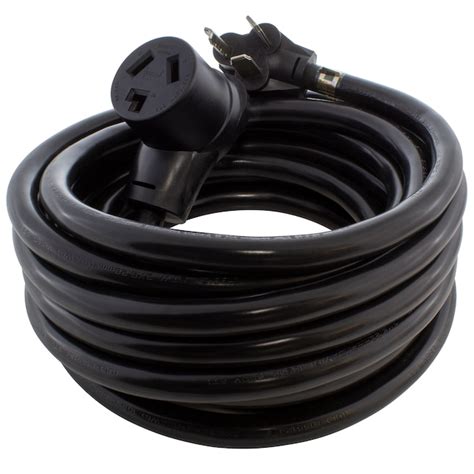The use of appliance extension cords has become a common practice in households and workplaces, providing a convenient solution for powering devices in areas where outlets are scarce. However, it is essential to understand the proper usage and safety precautions associated with these cords to avoid potential hazards. In this article, we will delve into the world of appliance extension cords, exploring their types, applications, and safety considerations.
Key Points
- Understanding the different types of appliance extension cords, including indoor, outdoor, and heavy-duty options
- Recognizing the importance of gauge and ampacity in selecting the right extension cord for a specific appliance
- Awareness of safety precautions, such as avoiding overloading and using cords in well-ventilated areas
- Familiarity with regulatory standards, including those set by UL (Underwriters Laboratories) and ETL (Intertek)
- Knowledge of proper cord maintenance and storage to prevent damage and ensure longevity
Types of Appliance Extension Cords

Appliance extension cords come in various types, each designed for specific applications and environments. Indoor extension cords are suitable for use in dry, indoor locations, such as homes and offices. Outdoor extension cords, on the other hand, are designed to withstand exposure to moisture and extreme temperatures, making them ideal for use in gardens, workshops, or construction sites. Heavy-duty extension cords are built to handle high-power appliances, such as refrigerators and air conditioners, and are often used in commercial settings.
Gauge and Ampacity: Understanding the Basics
When selecting an appliance extension cord, it is crucial to consider the gauge and ampacity of the cord. The gauge refers to the thickness of the cord, with lower gauge numbers indicating thicker cords. Ampacity, on the other hand, refers to the maximum amount of electrical current that the cord can safely handle. A higher ampacity rating indicates that the cord can handle more power, making it suitable for use with high-power appliances. For example, a 12-gauge cord with a 20-amp rating is suitable for use with appliances that require up to 20 amps of power, such as a refrigerator or a power tool.
| Gauge | Ampacity | Application |
|---|---|---|
| 18-gauge | 10-15 amps | Light-duty appliances, such as lamps and radios |
| 16-gauge | 15-20 amps | Medium-duty appliances, such as vacuum cleaners and toasters |
| 14-gauge | 20-25 amps | Heavy-duty appliances, such as refrigerators and air conditioners |

Safety Precautions and Regulatory Standards

Appliance extension cords can pose safety risks if not used properly. Overloading, which occurs when too many devices are plugged into a single cord, can lead to overheating and fires. To avoid this, it is essential to follow the manufacturer’s guidelines for the maximum number of devices that can be plugged into a cord. Additionally, cords should be kept away from heat sources, such as radiators and heaters, and should not be used in areas with high humidity or exposure to water.
Regulatory standards, such as those set by UL (Underwriters Laboratories) and ETL (Intertek), play a crucial role in ensuring the safety of appliance extension cords. These organizations test and certify cords to ensure that they meet specific safety standards, such as resistance to heat, moisture, and electrical shock. When purchasing an extension cord, look for the UL or ETL mark, which indicates that the cord has met these safety standards.
Proper Cord Maintenance and Storage
To ensure the longevity and safety of appliance extension cords, it is essential to maintain and store them properly. Cords should be inspected regularly for signs of damage, such as frays, cuts, or burns. Damaged cords should be replaced immediately to prevent electrical shock or fires. When not in use, cords should be stored in a dry, cool location, away from direct sunlight and moisture.
What is the difference between a 12-gauge and a 14-gauge extension cord?
+A 12-gauge extension cord is thicker and can handle more power than a 14-gauge cord. A 12-gauge cord is suitable for use with high-power appliances, such as refrigerators and air conditioners, while a 14-gauge cord is better suited for use with medium-duty appliances, such as vacuum cleaners and toasters.
Can I use an indoor extension cord outdoors?
+No, indoor extension cords are not designed to withstand exposure to moisture and extreme temperatures, and using them outdoors can pose a safety risk. Instead, use an outdoor extension cord, which is specifically designed for use in wet and dry locations.
How often should I inspect my extension cords for damage?
+It is recommended to inspect your extension cords regularly, ideally every 3-6 months, for signs of damage, such as frays, cuts, or burns. Damaged cords should be replaced immediately to prevent electrical shock or fires.
In conclusion, appliance extension cords can be a convenient and safe solution for powering devices in areas where outlets are scarce. However, it is essential to understand the proper usage and safety precautions associated with these cords to avoid potential hazards. By selecting the right cord for a specific appliance, following safety guidelines, and maintaining and storing cords properly, you can ensure the safe and efficient use of appliance extension cords.
Meta description suggestion: “Learn about appliance extension cords, including types, safety precautions, and regulatory standards. Discover how to choose the right cord for your needs and ensure safe and efficient use.” (147 characters)



